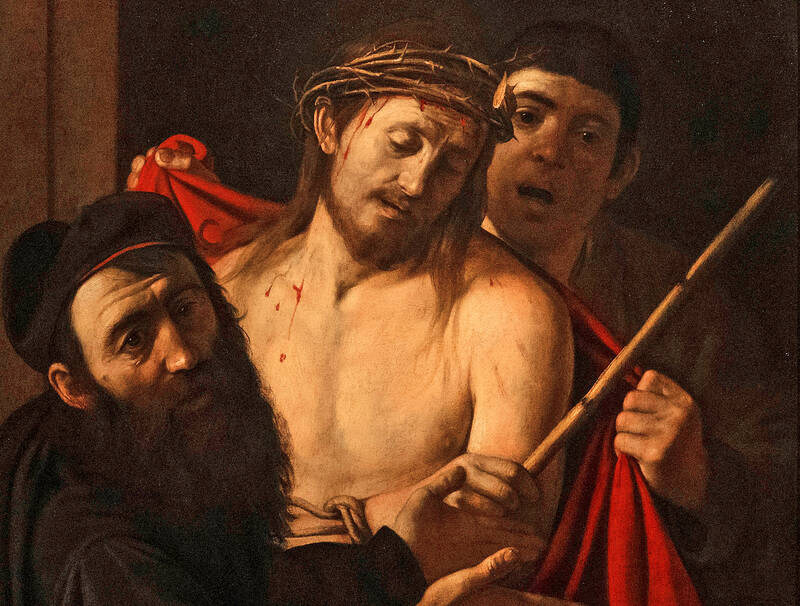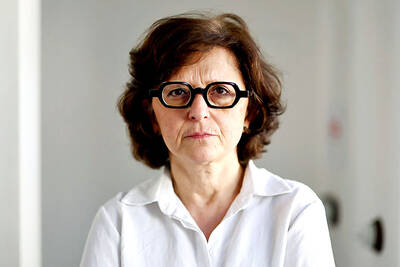A painting by Italian master Caravaggio, once mistakenly thought to be by an unknown artist and nearly auctioned off for a song, was unveiled on Monday at Madrid’s Museo del Prado.
Painted between 1605 and 1609, the dark, atmospheric canvas depicts a bloodied Jesus wearing a crown of thorns, his hands tied, as he is presented to the crowd by the Roman governor Pontius Pilate just before his crucifixion. Entitled Ecce Homo — Latin for “Behold the Man” — it is one of about only 60 known works by the Renaissance artist.
Three years ago, a Madrid auction house had been due to put the canvas under the hammer with an opening price of 1,500 euros (US$1,800 at the time), mistakenly attributing it to an artist from the circle of 17th-century Spanish painter Jose de Ribera.

Photo: AFP
However, just hours before the auction, the Spanish Ministry of Culture blocked the sale on concerns it was actually painted by Michelangelo Merisi da Caravaggio, whose works are worth millions.
The last-minute intervention came after the Prado said it had “sufficient documentary and stylistic evidence” to suggest the canvas was a Caravaggio. The artist, who lived a violent and chaotic life (1571-1610) pioneered the Baroque painting technique known as chiaroscuro, in which light and shadow are sharply contrasted.
Earlier this month, the museum said experts confirmed the painting was “without doubt, a Caravaggio masterpiece,” calling it “one of the greatest discoveries in the history of art.”
Now restored, the old master artwork went on display to the public for the first time on Monday in a one-piece exhibition called “The Lost Caravaggio.” It will remain on display for nine months.
The exhibition was made possible by the “generosity” of its new owner, who agreed to temporarily lend the work, Prado museum director Miguel Falomir told a news conference, without revealing who it was.
The painting’s emergence is “extremely important for the history of art, because there has been no new work by Caravaggio had been identified for more than 45 years,” said David Garcia Cueto, who is responsible for Italian paintings at the Prado.
Experts who have studied its history say this oil on canvas became part of the private collection of Spain’s King Felipe IV in the mid-17th century before being put on display at the residence of his son, Charles II. It was then bequeathed to the San Fernando Royal Academy of Fine Arts near Madrid’s central Puerta del Sol before being passed on to Spanish diplomat and later prime minister Evaristo Perez de Castro in 1823. When he died, it passed to his descendants, only to disappear from view for nearly two centuries until it resurfaced in April 2021. Its reappearance stunned Caravaggio experts who were “absolutely unanimous” in their recognition of the painting’s provenance, Cueto said.
“All the Caravaggio specialists are in agreement which means we are certain that this is a painting by the great master of this period,” he said.
One expert involved in the authentication process was Maria Cristina Terzaghi, an art history professor from Italy’s Roma Tre University who said the canvas underwent “radiographic” techniques and a “meticulous examination.”
She flew into Madrid after the auction was halted, saying her examination left her in no doubt.
“It was clear it was a work by Caravaggio,” she said at the time.
For her, the evidence was ample: from “the head of Christ” to the glow of his torso, the color of his cloak and “the three-dimensional nature of the three figures, who are offset in a transition that is almost cinematic.”
Spanish media reports said the owner was a British national living in Spain who had paid 36 million euros (US$39.2 million at the current exchange rate) for the 400-year-old canvas.
“The painting won’t end up in the home of the buyer” who wants to loan it to “public art collections for now,” Jorge Coll, head of London’s Colnaghi art gallery which handled the sale, told El Pais daily.
However, Falomir said its future was in the hands of its owner.
“It is a privately owned artwork so the owner will have the last word,” he said.

BACKLASH: The National Party quit its decades-long partnership with the Liberal Party after their election loss to center-left Labor, which won a historic third term Australia’s National Party has split from its conservative coalition partner of more than 60 years, the Liberal Party, citing policy differences over renewable energy and after a resounding loss at a national election this month. “Its time to have a break,” Nationals leader David Littleproud told reporters yesterday. The split shows the pressure on Australia’s conservative parties after Prime Minister Anthony Albanese’s center-left Labor party won a historic second term in the May 3 election, powered by a voter backlash against US President Donald Trump’s policies. Under the long-standing partnership in state and federal politics, the Liberal and National coalition had shared power

NO EXCUSES: Marcos said his administration was acting on voters’ demands, but an academic said the move was emotionally motivated after a poor midterm showing Philippine President Ferdinand Marcos Jr yesterday sought the resignation of all his Cabinet secretaries, in a move seen as an attempt to reset the political agenda and assert his authority over the second half of his single six-year term. The order came after the president’s allies failed to win a majority of Senate seats contested in the 12 polls on Monday last week, leaving Marcos facing a divided political and legislative landscape that could thwart his attempts to have an ally succeed him in 2028. “He’s talking to the people, trying to salvage whatever political capital he has left. I think it’s

CONTROVERSY: During the performance of Israel’s entrant Yuval Raphael’s song ‘New Day Will Rise,’ loud whistles were heard and two people tried to get on stage Austria’s JJ yesterday won the Eurovision Song Contest, with his operatic song Wasted Love triumphing at the world’s biggest live music television event. After votes from national juries around Europe and viewers from across the continent and beyond, JJ gave Austria its first victory since bearded drag performer Conchita Wurst’s 2014 triumph. After the nail-biting drama as the votes were revealed running into yesterday morning, Austria finished with 436 points, ahead of Israel — whose participation drew protests — on 357 and Estonia on 356. “Thank you to you, Europe, for making my dreams come true,” 24-year-old countertenor JJ, whose

A documentary whose main subject, 25-year-old photojournalist Fatima Hassouna, was killed in an Israeli airstrike in Gaza weeks before it premiered at Cannes stunned viewers into silence at the festival on Thursday. As the cinema lights came back on, filmmaker Sepideh Farsi held up an image of the young Palestinian woman killed with younger siblings on April 16, and encouraged the audience to stand up and clap to pay tribute. “To kill a child, to kill a photographer is unacceptable,” Farsi said. “There are still children to save. It must be done fast,” the exiled Iranian filmmaker added. With Israel